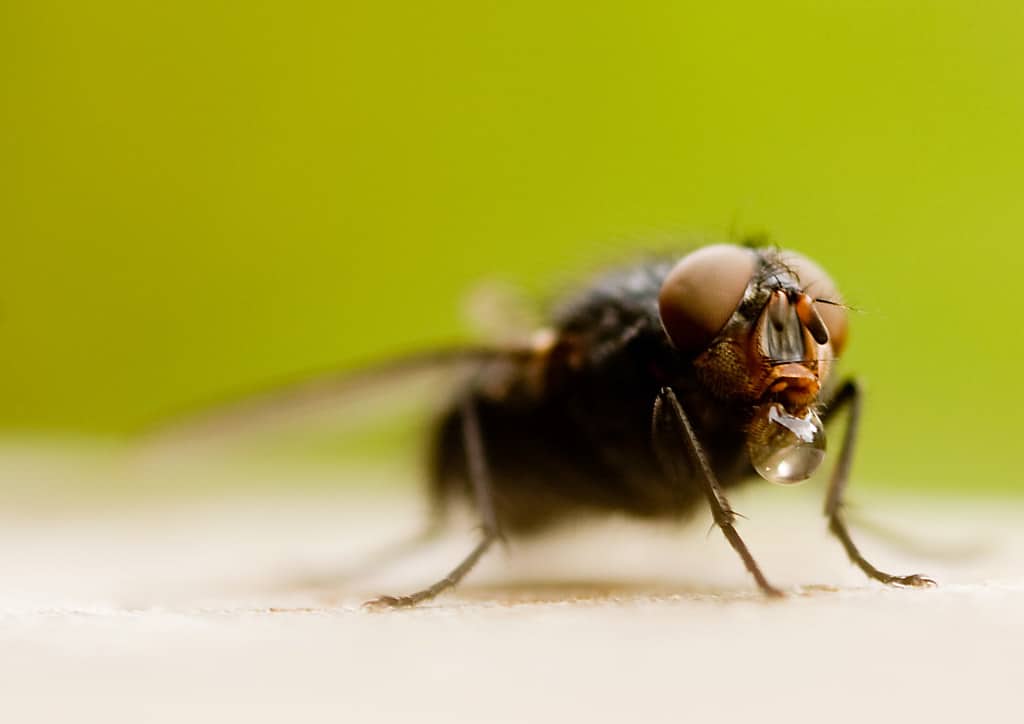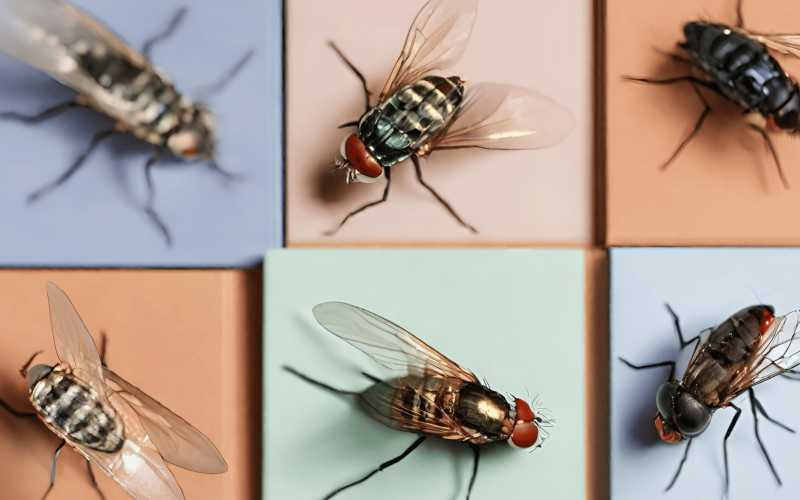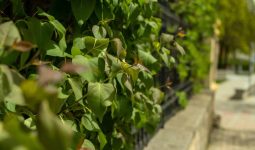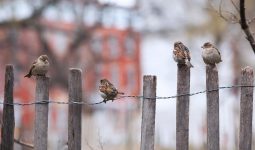A typical home has one or two flies flying around, constituting a nuisance.
So, you’re not alone if you’ve been experiencing this in your home. Flies are among the most unwelcome guests in everyone’s houses.
But they’re different species, so we’ll discuss some types of flies in the house.
We have the notorious housefly, which has a knack for landing on our meals. Then, there’s the tiny but persistent fruit fly attracted to overripe fruit.
While they may be tiny, annoying, or even a bit creepy, understanding them is the first step in dealing with them.
So, grab a flyswatter and join us as we uncover the 20 most common types of flies that may share your space!
1. Housefly

Musca domestica, popularly known as the housefly, is a frequent pest in homes.
The four distinct black stripes on their back may identify their grayish appearance.
They are not very big, only about a quarter of an inch.
These flies are famous for their quick flight and buzzing around our homes.
They don’t have the greatest palates and are attracted to unappealing items like trash, spoiled food, and, yes, even excrement.
They can, unfortunately, spread bacteria to our food and surfaces, making them potential carriers of germs.
The good news is that maintaining cleanliness, installing window screens, and disposing of waste correctly can help lower your house’s fly population.
2. Fruit Fly
The fruit fly is next on our list of the types of flies in the house.
Drosophila melanogaster, the scientific name for fruit flies, are the minuscule, bothersome insects frequently occurring in our kitchens and among overripe fruits.
These tiny animals always seem to find their way into our fruit dishes.
They are remarkable because of how fast they can reproduce.
Because fruit flies have a brief lifespan and can lay up to 500 eggs, it appears as though they multiply quickly.
Fruit flies swarm around ripe and ripening fruits because they are drawn to their sweet scent.
They can be pretty bothersome, but they’re not dangerous.
It’s crucial to keep your kitchen clean and eliminate overripe fruits immediately to keep them away from creating a haven for them.
3. Cluster Fly
Particularly in the late summer and fall, these flies can be annoying.
Their tendency to congregate in big groups, seek warmth and cover indoors during colder weather distinguishes them.
It’s interesting to note that they lay their eggs in earthworms rather than reproducing in our dwellings.
Compared to houseflies, cluster flies are larger and have a slower gait. They don’t present a health danger, yet their existence can be very bothersome.
Sealing gaps and fissures in your house can help keep them out by keeping them from entering in the first place.
4. Drain Fly
The tiny insects known as drain flies, often called “moth flies” or “sink flies,” are frequently seen in our homes, particularly in and around drains.
They are typically 1/8 inch long, and their small, stubby antennae and fuzzy appearance make them easy to identify.
These flies are found in moist, organic-rich areas, including sewage systems and clogged drains. They lay their eggs in the moist layer that develops in these places.
Then, these eggs hatch into larvae, which eat the decomposing organic materials.
They are, therefore, frequently discovered close to septic tanks and drains.
Cleaning and unclogging your drains regularly is crucial to removing drain flies.
Try combining baking soda and vinegar to discourage these bothersome insects and aid in the breakdown of organic build-up.
Keeping drains clear and dry is the secret to warding off these tiny fliers.
5. Stable Fly
Among the types of flies in the house is the stable fly. Stomoxys calcitrans, commonly known as the stable fly, is an annoying bug frequently confusing for a regular housefly.
Like the common housefly, the stable fly has a true knack for troubling people and animals alike.
Their name comes from these small troublemakers usually being seen close to stables and farms.
The stable fly is unique in that it prefers to feed on blood.
Yes, you read correctly! They consume animal blood, including that of horses, cows, and even people.
These bites can be highly bothersome because they can be unpleasant and irritating.
Further, stable flies breed in decomposing organic materials, such as manure; keeping your surroundings clean is essential to avoid their bites.
So, beware of these ferocious flies and take precautions to keep them away if you’re in a rural region or near cattle!
6. Blow Fly
The Calliphoridae family, which includes the blowfly, is an interesting but occasionally bothersome insect.
These flies have a distinctive appearance since they are frequently metallic in color, appearing in blue, green, or even black tones.
Their special place in nature’s cleanup team makes them stand out.
Decomposing organic materials, such as carcasses or rotting food, attracts blowflies.
Their larvae, known as maggots, deposit their eggs on these materials and aid in the decomposition of the organic debris.
Even though this may seem unpleasant, it is an essential component of the ecosystem’s nutrient-recycling process.
Therefore, even if they occasionally cause problems in our houses, they are vital to the balance of nature.
7. Horse Fly
Let’s discuss the Horse Fly, a quite unusual and occasionally bothersome bug.
Members of the Tabanidae family, horse flies are infamous for their excruciating bites.
With their enormous, frequently colorful eyes, these flies can be somewhat terrifying as they are larger than the typical housefly.
Horse flies are unique in that they have specific eating patterns.
Their main food source is mammal blood, including horses, cattle, and even people.
They bite by slicing through the skin with their scissor-like mouthparts, producing discomfort and occasionally allergic reactions in their prey.
These flies are more active throughout the day and are frequently found close to water sources.
Wearing protective clothes and applying insect repellents can help prevent their bites.
So, prepare to swat away the buzzing horse fly or, better yet, seek cover the next time you see one!
8. Deer Fly
The deer fly is next on our list of the types of flies in the house. Deer flies, sometimes called Chrysops flies, are bothersome insects you may encounter when engaging in outdoor activities.
Because of their excruciating bites, they frequently cause problems for both people and animals.
These flies have huge, frequently patterned wings and are usually dark in color.
The way deer flies feed is what distinguishes them. The females are the culprits here since they need blood to deposit their eggs.
Their bites can be painful, as they pierce the skin with mouthparts resembling scissors.
Wearing protective gear and applying insect repellent is a smart suggestion if you spend time in wooded regions or near water to keep these bothersome pests at bay.
9. Sand Fly
Although small, sand flies, called Phlebotomine sand flies, may be very annoying.
The bites of these little creatures are well-known for being extremely uncomfortable and bothersome.
As their name implies, they are frequently found in sandy or coastal environments.
The fact that certain sandfly species are also recognized to be carriers of diseases like leishmaniasis, a major health risk in several regions of the world, adds to their unsettling nature.
When you’re in an area where sandflies are common, it’s a good idea to wear long sleeves and apply insect repellent to protect yourself against bites.
Additionally, several anti-itch treatments will help lessen the pain if you get bitten.
10. Flesh Fly
The fascinating insect among the types of flies in the house, the Flesh Fly (Sarcophagidae), is frequently observed indoors and outdoors.
Its unusual reproductive habits distinguish it. Unlike many other flies, Flesh flies give birth to live larvae rather than eggs.
They lay their larvae in decomposing organic materials, such as rotting carcasses or food leftovers, and are frequently drawn to these areas.
These larvae are essential to the natural world because they aid in the breakdown and recycling of organic matter.
Although their name may sound scary, flesh flies are integral to our ecosystem’s decomposition process and are generally safe for humans.
11. Hoverfly
Hoverflies are interesting insects that resemble wasps and bees.
They are often referred to as flower flies or syrphid flies.
Their bodies are striped with black and yellow; they’re frequently confused with these stinging insects. Hoverflies, however, are benign and do not sting.
Their ability to function as pollinators is what sets them apart.
Like bees, hoverflies visit flowers to eat nectar and pollen; however, during this visitation, they also help facilitate plant reproduction by spreading pollen from one flower to another.
They are significant contributors to agriculture and our ecosystem since they pollinate many plants, including many crops.
These useful insects are a pleasant sight in gardens because they are entertaining to watch as they hover and dart about flowers.
12. Crane Fly
Because of its large legs, the crane fly is sometimes mistaken for a massive mosquito, yet it poses no threat to people.
These tiny insects are less interested in annoying us than mating and laying eggs. Unlike their mosquito-like counterparts, they do not bite or sting.
Due to their tiny bodies and spindly legs, crane flies have a distinctive appearance that can give them a scary aspect.
They are primarily concerned with surviving their brief adult life, which is spent without food. Rather, they depend on the energy that they save while still larvae.
Therefore, don’t panic if you see a crane fly in your home! They’re not doing any harm; they’re just passing by, going about their little, quiet lives.
13. Tachinid Fly
Among the types of flies in the house is the tachinid fly. The Tachinid Fly is an unusual and somewhat macabre insect with an interesting life cycle.
These flies are useful in gardening because they parasitize other insects, especially caterpillars.
A female Tachinid Fly deposits eggs on or close to a suitable host, like a caterpillar.
After hatching, the fly larvae burrow into their victim, feeding and developing until finally causing the host’s death.
Although it may sound harsh, this natural mechanism aids in managing insect populations in ecosystems.
Thus, even though they may not be the most physically pleasing insects, tachinid flies are essential to preserving the natural order of things!
14. Robber Fly
Robber flies are amazing insects frequently referred to as “aerial predators” in nature.
Their huge, strong wings and long, lean body give them a unique appearance. Their method of hunting is what draws us in so much.
As genuine hunters, these flies consume insects such as wasps, bees, and other flies.
They inject their prey with digestive and immobilizing enzymes using their powerful, piercing mouthparts.
In their environments, robber flies are essential for regulating insect populations and preserving ecological equilibrium.
Thus, keep in mind that robber flies are expert airborne predators that contribute to controlling the populations of other insects when you see them.
15. Black Fly
The black fly is the last on our list of the types of flies in the house.
Simulidae, another name for black flies, are small, blood-feeding insects infamous for their excruciating bites.
These little creatures are frequently seen in outdoor environments such as camping vacations and walks since they live close to swiftly moving streams and rivers.
They are frequently smaller than mosquitoes and have a characteristic humpbacked appearance.
The unpleasant bites of black flies are well-known for leaving behind itchy welts.
They contribute to ecosystems as a food source for various species, even though they can annoy humans.
When you come across these flies outside, using insect repellent is a good idea to lessen the discomfort and bites they cause.
Conclusion
Don’t flies make quite the eclectic group? Each type of fly, from fascinating hoverflies to bothersome houseflies, has a specific function in our ecology.
But it’s time to act when they decide to break into our houses. Remember that the first step to effective control is identifying the type of fly.
Happy combating flies!








